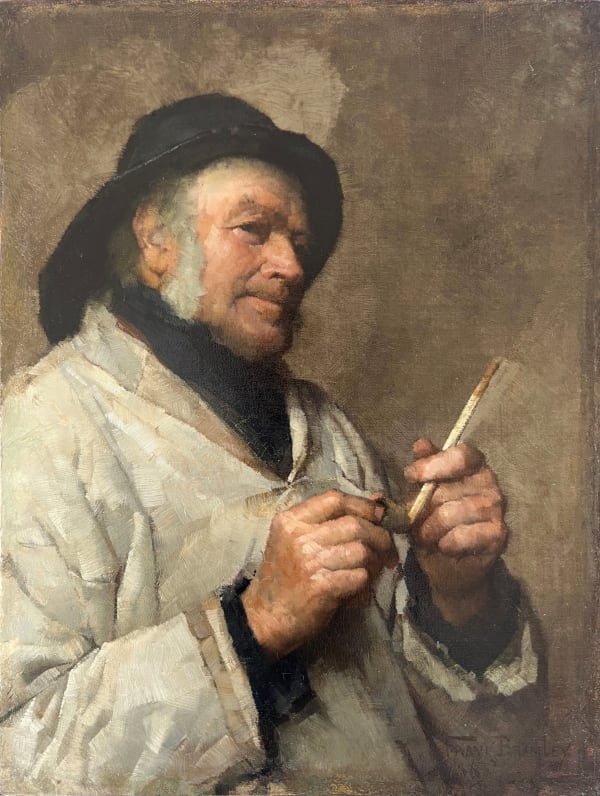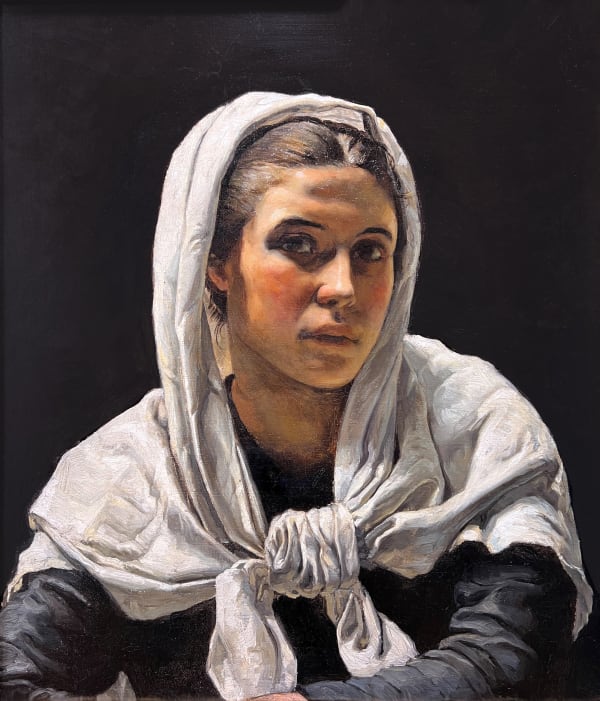Frank Bramley 1857-1915
-
 Frank BramleyTamping his pipe, 1886Oil on canvas laid to board41.0 x 30.9 cm (16 1/8 x 12 3/16 ins.)Sold
Frank BramleyTamping his pipe, 1886Oil on canvas laid to board41.0 x 30.9 cm (16 1/8 x 12 3/16 ins.)Sold
Framed 59.5 x 51.8cm (23 1/2 x 20 1/2 ins.)View full details -
 Frank BramleyFemme avec châle, 1881-82Oil on canvas61 x 51 cm (24 x 20 ins.)Sold
Frank BramleyFemme avec châle, 1881-82Oil on canvas61 x 51 cm (24 x 20 ins.)Sold
Framed: 81.3 x 73 cm (32 x 28 3/4 ins.)View full details
“Frank Bramley is arguably the most talented and dedicated of the Newlyn artists, who identified closely with the fishing community.” Tom Cross, The Shining Sands. Artists in Newlyn and St Ives, 1880-1930.
Frank Bramley was born on 6 May 1857 in Sibsey near Boston in Lincolnshire and trained at the Lincoln School of Art, as did Fred Hall. The principal, ER Taylor, had previously taught at the Birmingham School of Art where Harris and Langley studied.
Bramley went on to study at the Royal Academy of Antwerp (a remarkable art school established by David Teniers in the 17th century) along with William J Wainwright, Edwin Harris, Fred Hall, Norman Garstin and Leghe Suthers between 1879 and 1883. From 1878 to 1885 the Professor of Painting, later Director, was the much admired Charles Verlat. His students gained hugely from his realist approach and insistence upon technical competence and a study of the natural world. Remarkably, no fees were charged at the Antwerp Academy. Students mingled with talented peers from many European countries and were encouraged to paint en plein air.
In Antwerp Bramley became a close friend of Wainwright and for a time they shared a house together. Bramley exhibited paintings in the annual exhibitions of the Royal Birmingham Society of Artists from 1878 onwards. At the Antwerp Academy he won the coveted Concours competition.
Because of their previous training, 3 of the Lincoln/ Birmingham students, Bramley, Harris and Wainwright, were considered suitably advanced to join an elite group of students who had the use of a spacious studio in which full length life studies from the nude could be made without distraction.
Bramley summered in Pont Aven in 1881 and 1882 along with Edwin Harris, WA Breakespeare and Elizabeth Armstrong (later Forbes). They all stayed at ‘Julia’s' in Pont Aven but also took regular painting and social trips to the nearby coastal colony at Concarneau; a mere 10 miles to the west.
In 1882 Bramley made an extended visit to Venice. He enjoyed the student atmosphere and painted the city and Venetians with gusto; “Models in my opinion are very good. The colour of the costumes is as good as you could wish. The girls are very pretty and the men are mostly neatly made.” (from a letter to Wainwright). But the winters did not serve Bramley well; his health failing he departed in 1883 although on a more positive note, two of his Venetian works where his first accepted exhibits at the Royal Academy.
Bramley arrived in Newlyn in the winter of 1884, the same year as Stanhope Forbes, in the first influx of artists that followed Edwin Harris and Walter Langley who had settled there in 1882. Bramley was 27 years old and like his compatriots was seeking an English equivalent of the Breton colonies that he had so enjoyed and flourished in artistically. Like Forbes, his principal subject matter was the human figure but Bramley was more concerned with mood and character. He preferred indoor settings, where he could better study and transpose onto canvas the subtle effects of light and shade, and tonal harmonies in flesh and hair.
Bramley intially lived in cramped and relatively impoverished conditions in Newlyn; his home and studio a single room in a thatched cottage at the corner of a lane the artists had amusingly named, Rue des Beaux Arts.
In Newlyn, Bramley’s art began to mature and show off his very considerable gift to its full potential. Primrose Day, painted in Spring 1885 and now in the Tate collection, is a case in point but even more notably in 1886 he produced Domino, employing the same cottage interior but executed very overtly with the dragged straight marks of the square brush technique. Tom Cross provides a wonderful description of the technique; “Each change of colour was first carefully mixed on the palette and judged in relation to the surrounding tone and colour of the subject. It was then laid on the canvas to facet the change of light on dress, wall or table.” Despite its square brush technique, disparaging labelled ‘the French method’ by much of the English art establishment, Domino was exhibited at the Royal Academy in 1886 and was hailed an innovative translation of the new forms of realism into an indoor setting, and the first major interior scene to have emerged from the Newlyn School. One reviewer wrote of it, “A perfect blend of simple but profound human drama, and of beautifully executed and very carefully observed effects of light and colour and tone.” (Art Journal 1889). Wood described Bramley’s realism as that 'of Courbet and Millet, combined with the plein air landscape of the Barbizon painters.' In Newlyn Bramley remained one of the chief exponents of the square brush technique giving a particular vibrancy to the painted surface of his work.
Outside his artistic pursuit Frank Bramley was a keen cricketer. The first annual cricket match between the Newlyn and St Ives colonies of artists took place in 1886. Bramley was the Newlyn team captain; other players included Forbes, Langley, Chevalier Tayler, Harris and Rheam. These matches continued for years, were eagerly anticipated and not a little competitive.
In 1888, Arthur Bateman, a painter with a sharp sense of business, and from a wealthy London family, bought a field (‘The Meadow’) at the bottom of Rue des Beaux Arts where he built a studio for Stanhope Forbes and then, by contemporary accounts, a grander one for Frank Bramley; “a lovely glass house …. four sides and a roof of glass, a sort of dignified conservatory ..” (Bourdillon letters –Tom Cross, The Shining Sands).
Bramley’s most famous work is unquestionably A Hopeless Dawn (1888) of which Forbes remarked, “We have Frank Bramley’s picture which is not only very good for him, but I think one of the finest pictures I ever saw.” Tom Cross writes; “One of the greatest paintings to come from Newlyn and one of the finest emotional statements of Victorian art was ‘The Hopeless Dawn’, a scene of tragic loss set in the intimate theatre of Bramley’s small room in Newlyn.” The work is held by the Tate Gallery, London having been purchased for the nation by the Chantrey Bequest in 1888. It proved to be one of the most popular acquisitions, in a body of work that became the nucleus of the Tate collection.
Bramley was a founding member of New English Art Club in 1885, an institution designed to be a young artist’s alternative to the Royal Academy. Young English artists returning from France mounted the first exhibition in April 1886. Among them, in addition to Bramley, were the other leading Newlyn artists, Thomas Cooper Gotch and Stanhope Forbes. Walter Sickert joined in late 1887 and it soon became clear that this very vocal artist wanted to turn the NEAC into an English Impressionist society, in line with his own oeuvre. His dogged pursuit of this ambition resulted in a polarisation of the Newlyn en plein air painters and the impressionist group that coalesced around Sickert and Philip Wilson Steer. Sickert launched a vociferous and sustained attack on the work of the Newlyn painters, particularly outraged by the adulation that A Hopeless Dawn had won amongst critics and the public, becoming one of the most popular paintings of the decade. By 1890 the Newlyn painters could bear it no longer and resigned en masse, effectively recommitting themselves to the Royal Academy.
After a protracted love affair Bramley married his sweetheart Katherine Graham in 1891. From 1893-97 the Bramleys lived at Orchard Cottage (then Belle Vue Cottage), and then in 1889 at Belle Vue House. In 1894 Bramley was elected an Associate of the Royal Academy becoming a full Academician in 1911. In 1895, he served on the provisional committee of artists supporting the Passmore Edwards Art Gallery at Newlyn, and in the Opening Exhibition exhibited three pieces, the sketch for his large painting Saved being purchased by Elizabeth Forbes. Saved was another significant narrative piece and the last painting Bramley produced in his cramped cottage room before moving into the ‘glass house’ studio.
From the mid-1890s portraiture began to dominate Bramley’s output, the pursuit of which better suited a warm studio and convenient access to suitable patrons. The Bramleys moved to Droitwich later in 1895 and then on to Grasmere in 1900 (Katherine’s family home), before spending the last years of their lives in London. Frank Bramley died on 10 August, 1915, age 58, at Chalford, near Stroud in Gloucestershire,
Phryne comments that Bramley was the 'Newlyn School's answer to Moore and Whistler'. Of the artist Tom Cross concluded simply; “Frank Bramley is arguably the most talented and dedicated of the Newlyn artists.”
Fox, Caroline. Greenacre, Francis. Painting in Newlyn, 1880-1930. Barbican Art Gallery, 1985
Cross, Tom. The Shining Sands. Artists in Newlyn and St ives 1880-1930. Halsgrove, 1994
Thomas, Rosalyn. Frank Bramley R.A. 1857-1915. Usher Art Gallery, Lincoln, 1999
Conkey, Kenneth. The New English: A History of the New English Art Club. London: Royal Academy of Arts, 2006




